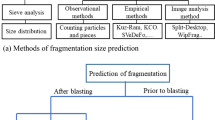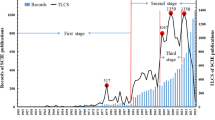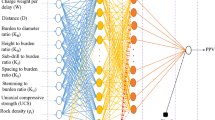Abstract
Blasting constitutes an essential component of the mining and construction industries. However, the associated nuisances, particularly blast vibration, have emerged as significant concerns that pose threats to operational stability and the safety of the surrounding areas. Given the increasing emphasis on sustainability, ecological responsibility, safety, and geo-environmental practices, the impact of blast vibration has garnered heightened attention and scrutiny. Nevertheless, the field still lacks comprehensive phase analysis studies. Therefore, it is imperative to elucidate the research progress on blast vibration and discern its current frontiers of investigation. To address this need, this study employs bibliometric methods and the CiteSpace 6.1.R2 software to analyze 3093 papers from the Web of Science database. Through this comprehensive analysis, the study aims to chronicle the developmental trajectory, assess the present research status, and identify future trends in the field of blast vibration. The findings of this study reveal that research on “blasting vibration” is advancing rapidly, with the number of citations exhibiting a J-shaped growth curve over time. China emerges as the leading contributor to this research, followed by India, and the foremost institution in this field is Central South University in China. Cluster analysis identifies the effects of ground vibration, numerical simulation, blast load, blasting vibration and rockburst hazard as the most prominent research areas presently. The primary research directions in this domain revolve around the rock fragmentation, compressive strength, particle swarm optimization, and ann. The emergence of these keywords underscores a dynamic shift towards a more holistic and multidisciplinary approach in the field of blasting-induced ground vibration. Furthermore, this study provides a concise overview of blast vibration, discusses prediction techniques, and proposes measures for its control. Additionally, the discussion delves into the social significance of intelligent blasting systems within the context of artificial intelligence, aiming to address the hazards associated with blast-induced ground vibrations.
















Similar content being viewed by others
Data availability
All data generated or analyzed during this study are included in this published article.
References
Adhikari GR, Theresraj AI, Venkatesh HS, Balachander R, Gupta RN (2004) Ground vibration due to blasting in limestone quarries. Fragblast 8(2):85–94
Ainalis D, Kaufmann O, Tshibangu JP, Verlinden O, Kouroussis G (2017) Modelling the source of blasting for the numerical simulation of blast-induced ground vibrations: a review. Rock Mech Rock Eng 50:171–193
Álvarez-Vigil AE, González-Nicieza C, Gayarre FL, Álvarez-Fernández MI (2012) Predicting blasting propagation velocity and vibration frequency using artificial neural networks. Int J Rock Mech Min Sci 55:108–116
Amiri M, Bakhshandeh Amnieh H, Hasanipanah M, Mohammad Khanli L (2016) A new combination of artificial neural network and K-nearest neighbors models to predict blast-induced ground vibration and air-overpressure. Eng Comput 32(4):631–644
Armaghani DJ, Hajihassani M, Mohamad ET, Marto A, Noorani SA (2014) Blasting-induced flyrock and ground vibration prediction through an expert artificial neural network based on particle swarm optimization. Arab J Geosci 7:5383–5396
Armaghani DJ, Hasanipanah M, Amnieh HB, Mohamad ET (2018) Feasibility of ICA in approximating ground vibration resulting from mine blasting. Neural Comput Applic 29:457–465
Blair DP, Armstrong LW (1999) The spectral control of ground vibration using electronic delay detonators. Fragblast 3(4):303–334
Chang YW, Huang MH, Lin CW (2015) Evolution of research subjects in library and information science based on keyword, bibliographical coupling, and co-citation analyses. Scientometrics 105:2071–2087
Chen C (2006) CiteSpace II: detecting and visualizing emerging trends and transient patterns in scientific literature. J Am Soc Inf Sci Tech 57(3):359–377
Chen C (2017) Science mapping: a systematic review of the literature. J Data Inf Sci 2(2):1–40
Chen C (2018) Visualizing and exploring scientific literature with Citespace: an introduction. In: Proceedings of the 2018 Conference on Human Information Interaction & Retrieval, pp 369–370
Chen C, Ibekwe-SanJuan F, Hou J (2010) The structure and dynamics of cocitation clusters: a multiple-perspective cocitation analysis. J Am Soc Inf Sci Tech 61(7):1386–1409
Comina C, Foti S (2007) Surface wave tests for vibration mitigation studies. J Geotech Geoenviron Eng 133(10):1320–1324
Ding Z, Nguyen H, Bui XN, Zhou J, Moayedi H (2020) Computational intelligence model for estimating intensity of blast-induced ground vibration in a mine based on imperialist competitive and extreme gradient boosting algorithms. Nat Resour Res 29(2):751–769
Dumakor-Dupey NK, Arya S, Jha A (2021) Advances in blast-induced impact prediction—a review of machine learning applications. Minerals 11(6):601
Duvall WI, Fogelson DE (1962) Review of criteria for estimating damage to residences from blasting vibrations, US Dept. of the Interior, Bureau of Mines. Report of investigations 5968
Fakhimi A, Lanari M (2014) DEM–SPH simulation of rock blasting. Comput Geotech 55:158–164
Faradonbeh RS, Armaghani DJ, Amnieh HB, Mohamad ET (2018) Prediction and minimization of blast-induced flyrock using gene expression programming and firefly algorithm. Neural Comput Applic 29:269–281
Freeman LC (2002) Centrality in social networks: conceptual clarification. Social network: critical concepts in sociology. Londres 1:238–263
Gao J, Wu X, Luo X, Guan S (2021) Scientometric analysis of safety sign research: 1990–2019. Int J Environ Res Public Health 18(1):273
Ghasemi E, Ataei M, Hashemolhosseini H (2013) Development of a fuzzy model for predicting ground vibration caused by rock blasting in surface mining. J Vib Control 19(5):755–770
Ghosh A, Daemen JK (1983) A simple new blast vibration predictor of ground vibrations induced predictor. In: The 24th U.S. Symposium on Rock Mechanics (USRMS), College Station, Texas, pp 83-0151
Gou Y, Shi X, Zhou J, Qiu X, Chen X, Huo X (2020) Attenuation assessment of blast-induced vibrations derived from an underground mine. Int J Rock Mech Min Sci 127:104220
Gou Y, Shi X, Huo X, Zhou J, Yu Z, Qiu X (2019) Motion parameter estimation and measured data correction derived from blast-induced vibration: new insights. Measurement 135:213–230
Guo H, Zhou J, Koopialipoor M, Jahed Armaghani D, Tahir MM (2021) Deep neural network and whale optimization algorithm to assess flyrock induced by blasting. Eng Comput 37:173–186
Gupta RN, Roy PP, Sing B (1988) On a blast induced blast vibration predictor for efficient blasting. In: Proceedings of the 22nd international conference of safety in mines, Beijing China, pp 1015–1021
Hajihassani M, Armaghani DJ, Marto A, Mohamad ET (2015) Ground vibration prediction in quarry blasting through an artificial neural network optimized by imperialist competitive algorithm. Bull Eng Geol Environ 74(3):873–886
Hajihassani M, Armaghani DJ, Monjezi M, Mohamad ET, Marto A (2015a) Blast-induced air and ground vibration prediction: a particle swarm optimization-based artificial neural network approach. Environ Earth Sci 74(4):2799–2817
Hasanipanah M, Amnieh HB, Arab H, Zamzam MS (2018) Feasibility of PSO–ANFIS model to estimate rock fragmentation produced by mine blasting. Neural Comput Applic 30:1015–1024
Hasanipanah M, Faradonbeh RS, Amnieh HB, Armaghani DJ, Monjezi M (2017) Forecasting blast-induced ground vibration developing a CART model. Eng Comput 33:307–316
Hasanipanah M, Noorian-Bidgoli M, Jahed Armaghani D, Khamesi H (2016) Feasibility of PSO-ANN model for predicting surface settlement caused by tunneling. Eng Comput 32:705–715
Hu Y, Lu W, Chen M, Yan P, Zhang Y (2015) Numerical simulation of the complete rock blasting response by SPH–DAM–FEM approach. Simul Model Pract Theory 56:55–68
Huang D, Cui S, Li X (2019) Wavelet packet analysis of blasting vibration signal of mountain tunnel. Soil Dyn Earthq Eng 117:72–80
Huo X, Shi X, Qiu X, Zhou J, Gou Y, Yu Z, Zhang S (2022) A study on raise blasting and blast-induced vibrations in highly stressed rock masses. Tunn Undergr Space Technol 123:104407
Jahed Armaghani D, Hasanipanah M, Tonnizam Mohamad E (2016) A combination of the ICA-ANN model to predict air-overpressure resulting from blasting. Engineering with Computers 32:155–171
Jiang N, Gao T, Zhou C, Luo X (2018) Effect of excavation blasting vibration on adjacent buried gas pipeline in a metro tunnel. Tunn Undergr Space Technol 81:590–601
Jiang Z, Xu H, Chen H, Gao B, Jia S, Yu Z, Zhou J (2021) Indirect determination approach of blast-induced ground vibration based on a hybrid SSA-optimized GP-based technique. Adv Civ Eng 2021:1–14
Khandelwal M, Armaghani DJ, Faradonbeh RS, Yellishetty M, Majid MZA, Monjezi M (2017) Classification and regression tree technique in estimating peak particle velocity caused by blasting. Eng Comput 33:45–53
Koçaslan A, Yüksek AG, Görgülü K, Arpaz E (2017) Evaluation of blast-induced ground vibrations in open-pit mines by using adaptive neuro-fuzzy inference systems. Environ Earth Sci 76:1–11
Langefors, U., & Kihlström, B. (1963). The modern technique of rock blasting.
Lawal AI, Kwon S, Hammed OS, Idris MA (2021) Blast-induced ground vibration prediction in granite quarries: an application of gene expression programming, ANFIS, and sine cosine algorithm optimized ANN. Int J Min Sci Technol 31(2):265–277
Li C, Zhou J, Khandelwal M, Zhang X, Monjezi M, Qiu Y (2022) Six novel hybrid extreme learning machine–swarm intelligence optimization (ELM–SIO) models for predicting backbreak in open-pit blasting. Nat Resour Res 31(5):3017–3039
Ma C, Wu L, Sun M, Lei D (2021) Failure mechanism and stability analysis of bank slope deformation under the synergistic effect of heavy rainfall and blasting vibration. Geotech. Geol. Eng 39(8):5811–5824
Minchinton A (2015) On the influence of fundamental detonics on blasting practice. In: Paper presented at the 11th international symposium on rock fragmentation by blasting, Sydney, pp 41–53
Nguyen H, Bui XN, Bui HB, Mai NL (2020) A comparative study of artificial neural networks in predicting blast-induced air-blast overpressure at Deo Nai open-pit coal mine. Vietnam Neural Comput Appl 32:3939–3955
Nguyen H, Bui XN, Tran QH, Mai NL (2019) A new soft computing model for estimating and controlling blast-produced ground vibration based on hierarchical K-means clustering and cubist algorithms. Appl Soft Comput 77:376–386
Nguyen H, Drebenstedt C, Bui XN, Bui DT (2020a) Prediction of blast-induced ground vibration in an open-pit mine by a novel hybrid model based on clustering and artificial neural network. Nat Resour Res 29:691–709
Prakash AJ, Palroy P, Misra DD (2004) Analysis of blast vibration characteristics across a trench and a pre-split plane. Fragblast 8(1):51–60
Qiu Y, Zhou J, Khandelwal M, Yang H, Yang P, Li C (2021) Performance evaluation of hybrid WOA-XGBoost, GWO-XGBoost and BO-XGBoost models to predict blast-induced ground vibration. Eng Comput 38:4145–4162
Saadat M, Khandelwal M, Monjezi M (2014) An ANN-based approach to predict blast-induced ground vibration of Gol-E-Gohar iron ore mine. Iran J Rock Mech Geotech Eng 6(1):67–76
Shirani Faradonbeh R, Jahed Armaghani D, Abd Majid MZ, Tahir MM, Ramesh Murlidhar B, Monjezi M, Wong HM (2016) Prediction of ground vibration due to quarry blasting based on gene expression programming: a new model for peak particle velocity prediction. Int J Environ Sci Technol 13:1453–1464
Taheri K, Hasanipanah M, Golzar SB, Majid MZA (2017) A hybrid artificial bee colony algorithm-artificial neural network for forecasting the blast-produced ground vibration. Eng Comput 33:689–700
Uttarwar M, Gurharikar M, Gujjula P (2020) Effect of blast induced ground vibrations on green concrete at Mumbai Metro Rail Project. Helix-The Scientific Explorer| Peer Reviewed Bimonthly. Int Dent J 10(01):51–55
Valdivia C, Vega M, Scherpenisse CR, Adamson WR (2003) Vibration simulation method to control stability in the Northeast corner of Escondida Mine. Fragblast 7(2):63–78
Verma AK, Singh TN (2011) Intelligent systems for ground vibration measurement: a comparative study. Eng Comput 27:225–233
Wei H, Chen J, Zhu J, Yang X, Chu H (2022) A novel algorithm of Nested-ELM for predicting blasting vibration. Eng Comput 38:1241–1256
Yan Y, Hou X, Fei H (2020) Review of predicting the blast-induced ground vibrations to reduce impacts on ambient urban communities. J Clean Prod 260:121135
Yu Z, Shi X, Zhou J, Gou Y, Huo X, Zhang J, Armaghani DJ (2020) A new multikernel relevance vector machine based on the HPSOGWO algorithm for predicting and controlling blast-induced ground vibration. Eng Comput 38:1905–1920
Yu Z, Shi X, Zhou J, Chen X, Qiu X (2020a) Effective assessment of blast-induced ground vibration using an optimized random forest model based on a Harris hawks optimization algorithm. Appl Sci 10(4):1403
Zhang C, Gholipour G, Mousavi AA (2019) Nonlinear dynamic behavior of simply-supported RC beams subjected to combined impact-blast loading. Eng Struct 181:124–142
Zhang X, Nguyen H, Choi Y, Bui XN, Zhou J (2021) Novel extreme learning machine-multi-verse optimization model for predicting peak particle velocity induced by mine blasting. Nat Resour Res 30:4735–4751
Zhang X, Nguyen H, Bui XN, Tran QH, Nguyen DA, Bui DT, Moayedi H (2020) Novel soft computing model for predicting blast-induced ground vibration in open-pit mines based on particle swarm optimization and XGBoost. Nat Resour Res 29:711–721
Zhang ZX, Lindqvist PA, Naarttijärvi T, Wikström K (2004) A feasibility study on controlling ground vibrations caused by blasts in Malmberget underground mine. Fragblast 8(1):3–21
Zhang H, Zhou J, Jahed Armaghani D, Tahir MM, Pham BT, Huynh VV (2020a) A combination of feature selection and random forest techniques to solve a problem related to blast-induced ground vibration. Appl Sci 10(3):869
Zhou J, Asteris PG, Armaghani DJ, Pham BT (2020a) Prediction of ground vibration induced by blasting operations through the use of the Bayesian Network and random forest models. Soil Dyn Earthq Eng 139:106390
Zhou J, Nekouie A, Arslan CA, Pham BT, Hasanipanah M (2020b) Novel approach for forecasting the blast-induced AOp using a hybrid fuzzy system and firefly algorithm. Eng Comput 36:703–712
Zhou J, Dai Y, Khandelwal M, Monjezi M, Yu Z, Qiu Y (2021a) Performance of hybrid SCA-RF and HHO-RF models for predicting backbreak in open-pit mine blasting operations. Nat Resour Res 30:4753–4771
Zhou J, Li C, Koopialipoor M, Jahed Armaghani D, Thai Pham B (2021b) Development of a new methodology for estimating the amount of PPV in surface mines based on prediction and probabilistic models (GEP-MC). Int J Min Reclam Environ 35(1):48–68
Zhou J, Qiu Y, Khandelwal M, Zhu S, Zhang X (2021c) Developing a hybrid model of Jaya algorithm-based extreme gradient boosting machine to estimate blast-induced ground vibrations. Int J Rock Mech Min Sci 145:104856
Zhou J, Shi X, Li X (2016) Utilizing gradient boosted machine for the prediction of damage to residential structures owing to blasting vibrations of open pit mining. J Vib Control 22(19):3986–3997
Zhou J, Zhang Y, Li C, He H, Li X (2023) Rockburst prediction and prevention in underground space excavation. Undergr Space. https://doi.org/10.1016/j.undsp.2023.05.009
Funding
This research was funded by the National Science Foundation of China (42177164) and the Distinguished Youth Science Foundation of Hunan Province of China (2022JJ10073).
Author information
Authors and Affiliations
Contributions
Yulin Zhang: methodology, software, formal analysis, visualization investigation, data curation, writing—original draft.
Haini He: visualization, validation, formal analysis.
Manoj Khandelwal: resources, writing—review and editing, validation.
Kun Du: software, investigation.
Jian Zhou: conceptualization, writing—review and editing, supervision, project administration, funding acquisition. All authors read and approved the final manuscript for publication.
Corresponding author
Ethics declarations
Ethics approval
Not applicable.
Consent to participate
The consent to participate statement was written according to the papers published in ESPR.
Consent for publication
All authors agreed to publish.
Conflict of interest
The authors declare no competing interests.
Additional information
Responsible Editor: Philippe Garrigues
Publisher’s Note
Springer Nature remains neutral with regard to jurisdictional claims in published maps and institutional affiliations.
Highlights
• Blast-induced ground vibrations studies were systematically and quantitatively analyzed by bibliometric methods with 2080 related papers published from 1990 to 2022.
• The influential authors and their relationships in this area were analyzed, and current hot topics and potential development trends are presented and discussed.
• Understanding, prediction, and mitigation measures of blast vibration are reviewed and discussed.
Rights and permissions
Springer Nature or its licensor (e.g. a society or other partner) holds exclusive rights to this article under a publishing agreement with the author(s) or other rightsholder(s); author self-archiving of the accepted manuscript version of this article is solely governed by the terms of such publishing agreement and applicable law.
About this article
Cite this article
Zhang, Y., He, H., Khandelwal, M. et al. Knowledge mapping of research progress in blast-induced ground vibration from 1990 to 2022 using CiteSpace-based scientometric analysis. Environ Sci Pollut Res 30, 103534–103555 (2023). https://doi.org/10.1007/s11356-023-29712-1
Received:
Accepted:
Published:
Issue Date:
DOI: https://doi.org/10.1007/s11356-023-29712-1




